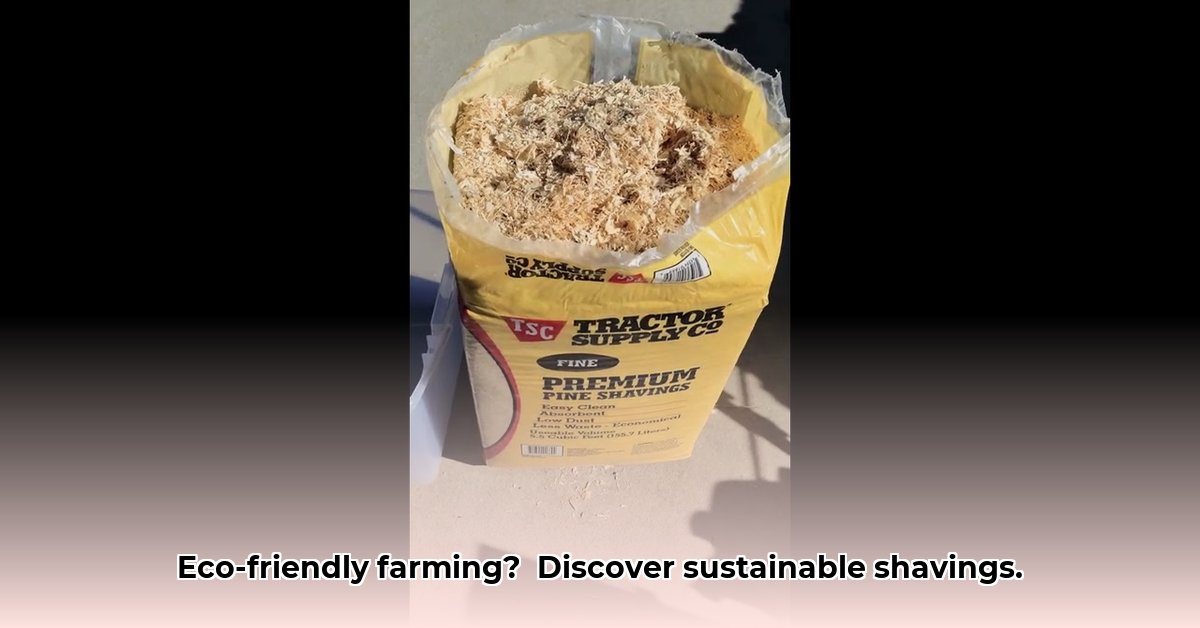
Pine Shavings in Sustainable Agriculture: A Comprehensive Guide
This article examines the sustainability of using pine shavings, readily available at Tractor Supply and similar retailers, as animal bedding in agricultural settings. We analyze the environmental impact, economic considerations, and practical implications for farmers, suppliers, and policymakers, offering a balanced perspective on this common practice. We explore both the benefits and drawbacks, highlighting opportunities for improvement and outlining actionable steps toward more sustainable farming. For more on Tractor Supply's role, see their website.
Assessing the Environmental Footprint of Pine Shavings
Pine shavings offer several advantages: they are absorbent, relatively inexpensive, and widely available. However, their environmental impact is complex and requires careful consideration. The sourcing of the pine, transportation distances to farms, and the disposal method all contribute to their overall sustainability profile. Are the benefits of convenience and cost offset by the environmental costs?
Production and Sourcing: A Closer Look
The sustainability of pine shavings depends heavily on the forestry practices employed in their production. Sustainably managed forests, utilizing responsible harvesting techniques, minimize environmental damage. However, the transportation involved in getting these shavings from the mill to retailers like Tractor Supply, and then onto farms, generates carbon emissions. Locally sourced shavings significantly reduce this transportation impact, highlighting the importance of sourcing from local suppliers whenever possible. A key question to consider: What is the carbon footprint of transporting pine shavings to your farm?
Disposal and Decomposition: Minimizing Waste
The disposal of used pine shavings presents another challenge. Landfilling this organic matter contributes to greenhouse gas emissions (primarily methane). Composting, however, transforms this waste into valuable fertilizer, reducing landfill burden and enriching soil. Anaerobic digestion, a more complex process, further enhances sustainability by producing biogas as a renewable energy source. What disposal strategy is most feasible and environmentally responsible for your operation?
Economic Considerations: Balancing Cost and Sustainability
While pine shavings are generally cost-effective compared to some alternatives, the true economic picture includes the costs associated with transportation, disposal, and potential loss of productivity due to inadequate bedding. A comprehensive cost-benefit analysis should weigh these factors against the initial purchase price. What are the total costs—environmental and economic—associated with using pine shavings versus alternative bedding materials?
Alternative Bedding Materials: Expanding the Options
Farmers should explore alternative bedding materials, such as straw, recycled paper, or wood pellets. Each option presents a unique profile of costs, benefits, and environmental impacts. A life cycle assessment (LCA), considering factors from production to disposal, is crucial for informed decision-making. Dr. Emily Carter, Professor of Environmental Engineering at Cornell University, notes that "a comprehensive LCA is essential for determining the true environmental impact of any agricultural input, allowing for more informed choices about sustainable practices." What alternative bedding options are available in your region, and how do their sustainability profiles compare to pine shavings?
Actionable Steps Towards Sustainable Shaving Use
Sustainable management of pine shavings requires proactive measures from all stakeholders. The following steps offer a pathway toward a more ecologically responsible approach:
- Prioritize Local Sourcing: Farmers should actively seek locally sourced pine shavings to minimize transportation emissions. This approach reduces the overall carbon footprint.
- Invest in Composting Infrastructure: Appropriate composting or anaerobic digestion facilities are vital for responsible waste management, transforming used shavings into a beneficial soil amendment. This practice drastically reduces landfill use and methane emissions.
- Explore Alternative Bedding: Farmers should thoroughly investigate alternative materials, weighing their economic and environmental costs against the advantages.
- Promote Sustainable Forestry Practices: Suppliers should source pine from sustainably managed forests. Transparent labeling and reporting on sustainable harvesting practices would allow for informed consumer choices.
- Support Research and Development: Government agencies should fund research into sustainable bedding alternatives and improve the data available for comprehensive LCAs. This informed decision-making is crucial.
Conclusion: A Sustainable Future for Animal Bedding
The use of pine shavings from Tractor Supply, while cost-effective and readily accessible, demands careful consideration regarding its environmental implications. By prioritizing local sourcing, responsible disposal, and exploring alternatives, the agricultural community can minimize the environmental footprint of animal bedding and promote truly sustainable farming practices. The future of sustainable agriculture requires a collaborative effort from farmers, suppliers, and policymakers to create a more efficient and environmentally conscious industry.